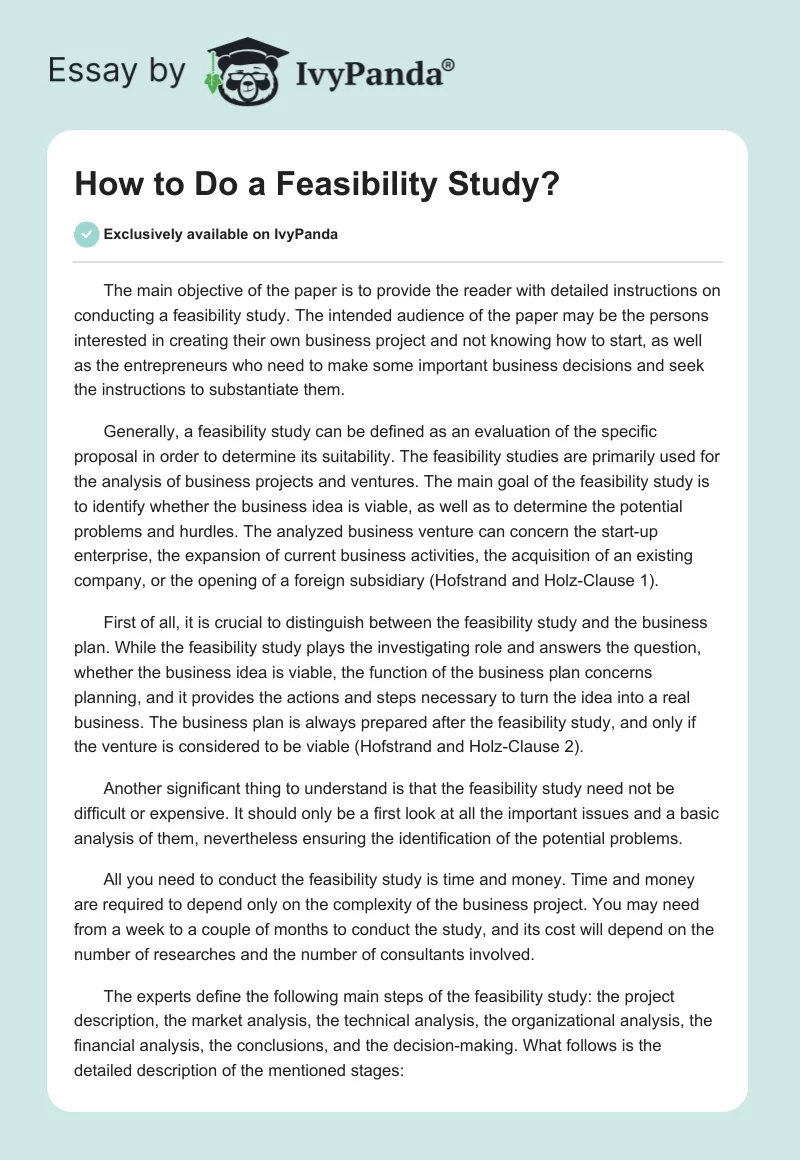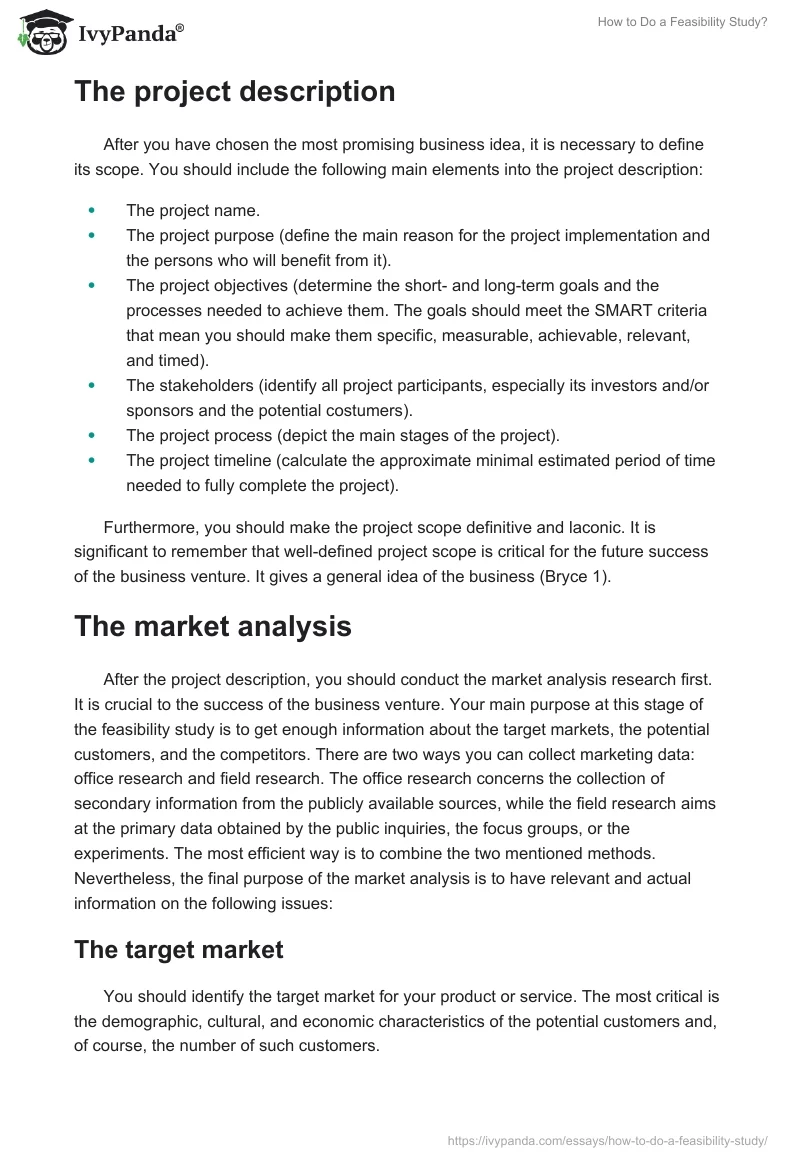The main objective of the paper is to provide the reader with detailed instructions on conducting a feasibility study. The intended audience of the paper may be the persons interested in creating their own business project and not knowing how to start, as well as the entrepreneurs who need to make some important business decisions and seek the instructions to substantiate them.
Generally, a feasibility study can be defined as an evaluation of the specific proposal in order to determine its suitability. The feasibility studies are primarily used for the analysis of business projects and ventures. The main goal of the feasibility study is to identify whether the business idea is viable, as well as to determine the potential problems and hurdles. The analyzed business venture can concern the start-up enterprise, the expansion of current business activities, the acquisition of an existing company, or the opening of a foreign subsidiary (Hofstrand and Holz-Clause 1).
First of all, it is crucial to distinguish between the feasibility study and the business plan. While the feasibility study plays the investigating role and answers the question, whether the business idea is viable, the function of the business plan concerns planning, and it provides the actions and steps necessary to turn the idea into a real business. The business plan is always prepared after the feasibility study, and only if the venture is considered to be viable (Hofstrand and Holz-Clause 2).
Another significant thing to understand is that the feasibility study need not be difficult or expensive. It should only be a first look at all the important issues and a basic analysis of them, nevertheless ensuring the identification of the potential problems.
All you need to conduct the feasibility study is time and money. Time and money are required to depend only on the complexity of the business project. You may need from a week to a couple of months to conduct the study, and its cost will depend on the number of researches and the number of consultants involved.
The experts define the following main steps of the feasibility study: the project description, the market analysis, the technical analysis, the organizational analysis, the financial analysis, the conclusions, and the decision-making. What follows is the detailed description of the mentioned stages:
The project description
After you have chosen the most promising business idea, it is necessary to define its scope. You should include the following main elements into the project description:
- The project name.
- The project purpose (define the main reason for the project implementation and the persons who will benefit from it).
- The project objectives (determine the short- and long-term goals and the processes needed to achieve them. The goals should meet the SMART criteria that mean you should make them specific, measurable, achievable, relevant, and timed).
- The stakeholders (identify all project participants, especially its investors and/or sponsors and the potential costumers).
- The project process (depict the main stages of the project).
- The project timeline (calculate the approximate minimal estimated period of time needed to fully complete the project).
Furthermore, you should make the project scope definitive and laconic. It is significant to remember that well-defined project scope is critical for the future success of the business venture. It gives a general idea of the business (Bryce 1).
The market analysis
After the project description, you should conduct the market analysis research first. It is crucial to the success of the business venture. Your main purpose at this stage of the feasibility study is to get enough information about the target markets, the potential customers, and the competitors. There are two ways you can collect marketing data: office research and field research. The office research concerns the collection of secondary information from the publicly available sources, while the field research aims at the primary data obtained by the public inquiries, the focus groups, or the experiments. The most efficient way is to combine the two mentioned methods. Nevertheless, the final purpose of the market analysis is to have relevant and actual information on the following issues:
The target market
You should identify the target market for your product or service. The most critical is the demographic, cultural, and economic characteristics of the potential customers and, of course, the number of such customers.
The size of the market
You have to estimate the current or potential demand for your products or services on the target market. To be more precise, it is necessary to calculate the approximate quantity of the product units you expect to sell every month.
The projected market share
Pursuant to the estimated volume of your sales and the total size of the market, you should calculate your projected market share.
The analysis of the competition
It is important to identify the companies which produce similar products, their location, prices, and quality of their products. You should decide whether you are able to make your product better than competitors and whether potential customers are likely to change to a new product. It is also necessary to find out if any barriers to entering the market exist. At this stage of the study, the SWOT-analysis can be very useful. With the help of the SWOT-analysis, you will be able to identify the strengths, weaknesses, opportunities, and threats for your business, as well as for the competitors’ ones, and compare the information.
After the successful market research, you will be able to determine if the demand for your product or service is adequate and meets your expectations and objectives and whether you can compete with the key players on the market. If the answer is yes, you should proceed to the next stage of the feasibility study; otherwise, the project is not viable (Lawless et al.).
The technological analysis
At this stage of the feasibility study, you are to analyze the next issues:
The need for the technologies and equipment
You have to determine your need for machinery and equipment. The service organizations may need less equipment while the manufacturing enterprises may have to decide many complex technical questions.
The availability and the cost of the necessary technologies
After you have determined what and how much equipment you need for the business project, it is significant to find out where to purchase the equipment and how much it will cost.
The maintenance and repair of the equipment
It is crucial to have the skilled personnel to ensure the proper maintenance of your equipment, as well as the service companies to repair it and provide the spare parts if necessary.
It is important to notice that technology is not only some complex machinery, but also simple equipment such as office machines (personal computers, printers, etc.), and they require research too. Of course, the more complicated the equipment you need, the more research and analysis you should carry out (Lawless et al.). Be careful not to underestimate the technical analysis as part of the feasibility study, as any business project will be impossible without the appropriate technological background.
Organizational analysis
The choice of your project organizational structure
It is critical to choose the proper form of the legal business structure before you continue with the further feasibility study. All the significant subsequent decisions depend on the form of your company, whether a joint-stock venture or a private enterprise.
The selection of the personnel
You should think over all the staffing questions and plan the number of the employees and their qualifications and skills (Lawless et al.).
The financial analysis
This stage of the feasibility study is closely connected to the previous ones. If you have not conducted them thoroughly, you will not be able to do adequate financial analysis. You have to cover the following issues:
The start-up costs
You have to estimate the costs indispensable to start your business, namely to purchase land, buildings, and machinery.
The operating costs
Here you should assess the ongoing costs (rent, utilities, and salaries).
The sources of the financing
You should determine how to finance the above-mentioned costs – the size of the equity capital and the necessary sum of the loans; therefore, you have to research the potential lending sources.
The revenue projections
Pursuant to the market analysis, you must be able to estimate your revenues from the selling of your products or services (taking the estimated quantity of the product units you expect to sell every month and their reasonable price).
The profitability analysis
Based on the costs and revenues analyzed above, you should determine whether your project will be profitable or not (Lawless et al.). Even the prospect to break even for the first few months will prove the feasibility of the business venture. However, in case your calculations will show huge losses, you will have to return to the previous stages of the study in order to find out which aspects can be improved. If nothing can be improved, the project is not viable.
It is significant to mention that at this stage, you do not need to calculate the complex financial indicators. The only purpose is to determine the potential profitability of the project.
The conclusions
At this stage of the feasibility study, you have to take a skeptical view of the study, identify its strengths and weaknesses, decide whether it is thorough and accurate enough. If you decide that you have done your best conducting the research, you can move to the final step of the feasibility study.
The decision-making
All the previous stages of the feasibility study you have conducted aimed at providing the quality information, and analysis for the “go/no go” decision. Generally, if the study shows that the project will bring in the desired minimum income, and there is the potential for future growth, you should take a “go” decision. However, the feasibility study has not necessarily to be positive or negative, and some ambiguous outcomes may emerge.
Maybe you will decide to revise the study, or the situation will demand of you to make a decision relying on your subjective feelings and premonitions concerning the project. Nevertheless, if the business proposal is rejected, you should explain the reasons and attach them to the study. If you decide to proceed with the project, you can start developing the business plan. In both cases, you can consider that the feasibility study has played its role.
Works Cited
Bryce, Tim. n.d., The Elements of a Good Feasibility Study. Web.
Hofstrand, Don, and Holz-Clause Mary 2009, What is a Feasibility Study? Web.
Lawless, Greg, Myers Mary and Nadeau, E.G., 1998. Cooperatives: A Tool for Community Economic Development. Conducting a Feasibility Study. Web.


